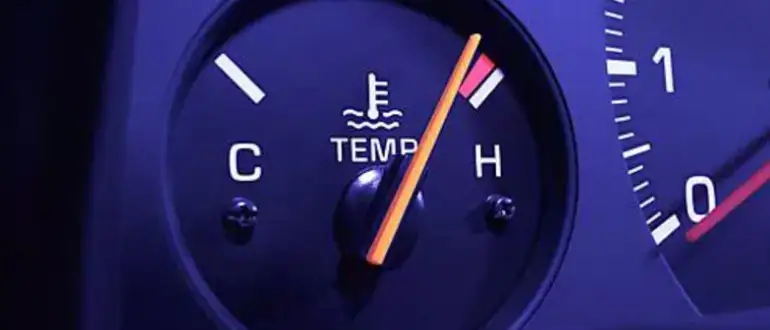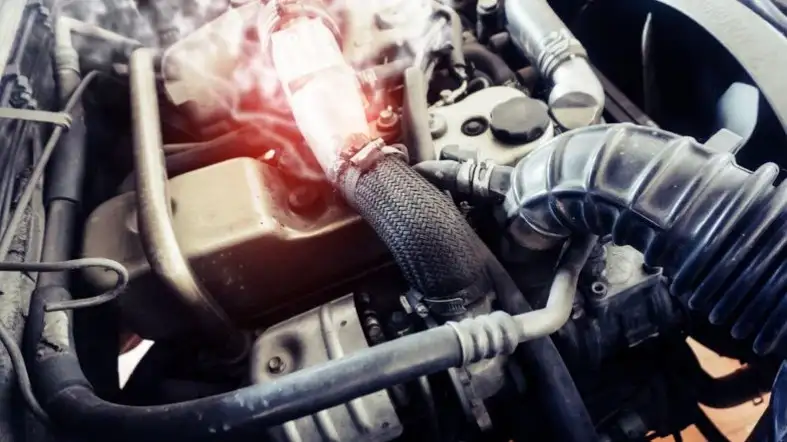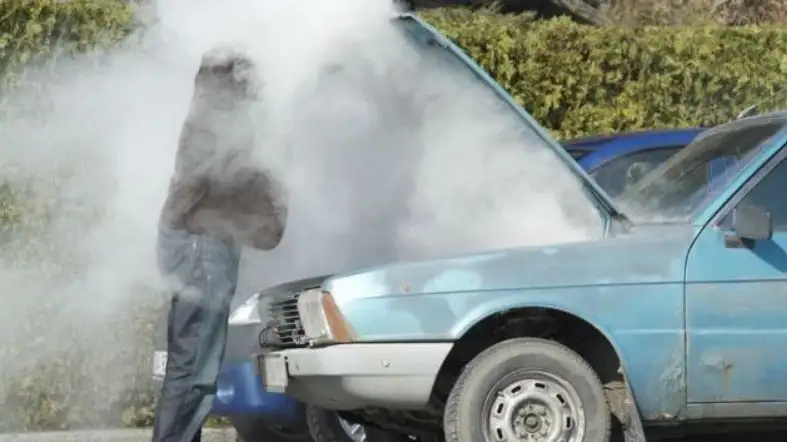Are you worried if 230 degrees is too hot for your engine? Delve into our 2025 expert guide for insights.
Discover signs of engine overheating and ways to prevent it. Learn why 230 degrees Fahrenheit is typically safe but requires caution.
Prioritize maintenance, use the right coolant, and monitor your engine closely. Stay vigilant to prevent potential damage.

Is 230 Degrees Too Hot For An Engine?
No, 230 degrees Fahrenheit is not at all too hot for an engine. But it’s crucial to monitor it closely and be cautious if it approaches 240 degrees Fahrenheit or higher, as this may indicate overheating.
Signs Your Engine is Overheating
Here are some of the common signs of engine overheating:

Rising Temperature Gauge
The most noticeable proof of engine overheating is when the temperature gauge on your dashboard exceeds the norm.
Your car model and weather conditions can affect the normal range which is usually between 195 and 220 degrees Fahrenheit.
If the gauge exceeds 230 degrees Fahrenheit, you should stop your car right away.
Steam from the Hood
A warning sign of engine overheating may be seen when you see smoke or steam coming out from under the hood of your car.
This means that your coolant which is a liquid that helps cool down your engine is boiling and evaporating.
This can lead to a burning odor, or the smell of sugar depending on the type of coolant you are using.
Reduced Engine Power
This may cause your engine to lose power and performance when it overheats. You may notice that your car is slower, noisier, or less effective.
Excessive heat can spoil the internal parts of an engine such as pistons, valves, cylinders, and gaskets.
Ticking Noises
There is another sign of overheating when you hear a ticking noise from the engine. This implies that the engine loses its oil that normally lubricates and shields the engine parts.
This is due to the metal parts rubbing against each other in the absence of sufficient oil.
Coolant Leak
If you see a green, orange, or yellow puddle under your car, you have a coolant leak. Cracks, holes, and loosened connections in your cooling system can cause coolant leaks.
Leaky coolants can make your engine overheat quickly due to a reduced amount of coolant to circulate through your engine.
Burning Smell
There is a possibility that your engine is overheating when you smell something burning while driving.
Your coolant, oil, or other fluids may be overheating and catching fire this is the burning smell.
You could also be getting the burning smell from your belts hoses, or wires that are melting or breaking down due to the heat.
Erratic RPM
If your RPM gauge jumps up and down randomly, it might mean that the engine is overheating.
RPM gauge indicates how many revolutions per minute your engine is spinning.
Your engine can overheat and affect the sensors and computers that control your engine speed. Your RPM gauge can be affected by this making it behave erratically.
Diminished AC Output
If your AC system is not cooling down your car as much as before, it could be a sign of engine overheating.
In the case of the AC system, the compressor functions on the engine power of your vehicle.
An overheated engine can reduce the power available to your AC compressor. This can reduce the effectiveness of your AC system.
Dashboard Warning Lights
Another sign of an engine overheating is the warning lights on your dashboard. The lights are meant to notify you that something is wrong with your car.
The most common warning lights for engine overheating are usually the check engine light and the temperature light.
The check engine light is engine shaped, while the temperature light is shaped like a thermometer.
Factors Contributing to Overheating in Engines
Factors that can contribute to overheating in engines:

Can I Add Coolant To Reservoir When Engine Is Hot?
Ambient Temperature
Ambient temperature means the temperature of the air around your car.
The more the ambient temperature, the more difficult it is for your cooling system to keep the temperature of the engine at a safe level.
So, the engines tend to overheat often in hot weather or when stuck in a traffic jam.
Vehicle Speed and Load
Your vehicle speed and load how fast and how heavy your car is moving.
The more work your engine has to do is proportional to the speed and weight of your car.
That means your engine generates more heat and requires more cooling.
As a result, that’s why the engines overheat more often when you go uphill, tow a trailer, or increase speed fast.
Condition of the Cooling System
Your cooling system’s performance is the current condition of your cooling system.
The cooling system includes various components such as the radiator, the water pump, the thermostat, the hoses, and the fans.
These parts help transfer heat from your engine to the air.
Failure to clean and/or inspect any of these parts will lead to a malfunction of the cooling system and the engine will overheat.
Engine Tuning and Modifications
To adjust or change your engine to improve its performance, you use engine tuning and modifications.
For some individuals, their engines need to be tuned in order to get better speed, more power, or more fuel economy.
But these alterations may affect your engine’s heat production as well as it requires.
If you do not consider the cooling system in your tuning or modification of the engine, your engine may overheat.
Blockages or Leaks in the System
Something that will prevent the coolant from flowing in your cooling system is a blockage or leak, in the system.
These blockages may occur in your hoses, pipes, or radiator owing to dirt, rust, debris, and air bubbles.
Leaks can occur through cracks, holes, or loose connections that allow the coolant to escape from your system.
Your engine can overheat as a result of blockages or leaks which reduce the amount of coolant available for it.
Age and Maintenance History of the Engine
Your engine runs to the extent of how old and maintained it is. Wear and tear, corrosion, and sediments accumulating in an older machine make it more prone to overheating.
The cooling system may also become less effective as a result of these issues.
Use of Incorrect or Low-Quality Coolants
Incorrect or poor coolants are when you use the wrong type or quality coolant for your car. Coolant is the liquid that is used to cool down the engine when the heat is absorbed and passed on to the coolant.
However, all coolants are not the same. Different cars require different types of coolants. When you use the wrong type or quality of coolant, it might spoil your cooling system and cause your engine to overheat.
How to Prevent and Address Engine Overheating
Here are some tips on how to prevent and address engine overheating:
Regular Maintenance Check-ups
The easiest way to keep your car’s engine from overheating is to have regular maintenance checks.
You should monthly check the coolant level and condition, in addition, change it every two years or according to your owner’s manual.
Make sure to check the parts of your cooling system for any damage, wear, or leaks. If you spot any problems, correct them immediately.
Using the Right Coolant
In addition, there is another method to avoid car engine overheating; by using suitable coolant.
However, always refer to your owner’s manual to find out what type and quality of coolant to use in your engine.
Likewise, you should never put together different kinds or brands of coolants. This could result in different chemical reactions leading to damaging effects in your cooling system such as overheating of the engine.
Installing a High-Performance Radiator
Consider putting in a high-performance radiator if you do not want your car engine overheating.
A regular radiator just has a surface area, whereas a typical one has more stuff like fins, fins, tubes, or fans. These extra parts assist in cooling the coolant so it doesn’t overheat and cause engine problems.
Ensuring Proper Airflow
You may also solve this problem by improving the airflow around your vehicle. Your radiator and your engine also need cooling airflow.
Ensure your radiator is free of any obstructions like dirt, leaves, bugs, or any other debris.
It is also necessary for you to ensure that there is sufficient space between your car and other cars or objects while parking as well as while driving. This will enable fresh air to enter and cool your car.
Monitoring Engine Performance and Heat
Finally, keep an eye on your engine’s performance and heat to address engine overheating.
Remember to keep an eye on the temperature gauge of your dashboard and beware of the symptoms of overheating.
If your engine is getting too hot, do not drive any further, turn off your engine. Remember, call a mechanic or a tow truck.
FAQs about 230 degrees temperature for an engine:
Can engine temperature of 250 degrees harm my car?
No, engine temperature of 250 degrees is extremely high and can cause severe damage to your car.
Is it safe to continue driving if my engine overheats?
No, it’s not safe to continue driving when your engine overheats. Stop the car, turn off the engine, and seek assistance.
How long does it take for an overheated engine to cool down?
For most car models, it should take around 30 minutes for an overheated engine to cool down, but consult your car’s manual or a mechanic for precise guidance.
Can using the wrong coolant cause engine overheating?
Yes, using the wrong coolant type or quality can lead to engine overheating and damage to the cooling system.
Are high-performanceradiators effective in preventing engine overheating?
Yes, high-performance radiators can help prevent engine overheating by providing enhanced cooling capabilities.
Do ambient temperature and vehicle speed affect engine overheating?
Yes, ambient temperature and vehicle speed can influence engine overheating, with higher temperatures and heavier loads causing more overheating.
Does monitoring dashboard warning lights help prevent engine overheating?
Yes, monitoring warning lights like the check engine and temperature light can alert you to potential overheating issues and prompt timely action.
Final Words
230 degrees Fahrenheit is typically a safe operating temperature for an engine.
However, surpassing 230 degrees Fahrenheit indicates potential overheating issues.
To prevent this, prioritize regular maintenance, use the right coolant, consider high performance radiators, ensure proper airflow, and closely monitor engine performance.
Timely action in case of overheating is critical to prevent significant engine damage, so stay vigilant for a trouble-free journey.
